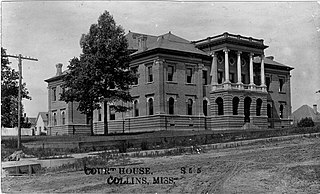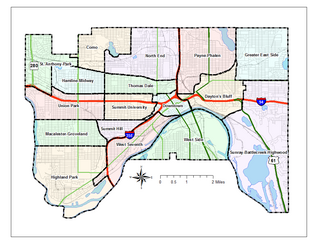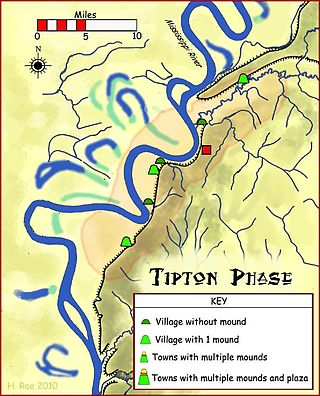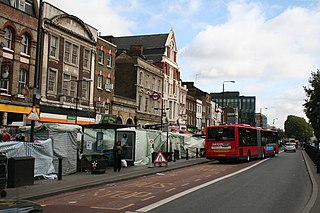
Scotland County is a county located in the southern part of the U.S. state of North Carolina. Its county seat is and largest city is Laurinburg. The county was formed in 1899 from part of Richmond County and named in honor of the Scottish settlers who occupied the area in the 1700s. As of the 2020 census, its population was 34,174.

Jefferson Davis County is a county located in the U.S. state of Mississippi. As of the 2020 census, the population was 11,321. Its county seat is Prentiss. The county is named after Mississippi Senator and Confederate President Jefferson Davis. The county was carved out of Covington and Lawrence counties in March 1906. Governor James K. Vardaman signed the bill creating the county on May 9, 1906.

Covington County is a county located in the U.S. state of Mississippi. As of the 2020 census, the population was 18,340. Its county seat is Collins. The county is named for U.S. Army officer and Congressman Leonard Covington.

Covington is a city in, and the parish seat of, St. Tammany Parish, Louisiana, United States. The population was 11,564 at the 2020 United States census. It is located at a fork of the Bogue Falaya and the Tchefuncte River. Covington is part of the New Orleans–Metairie–Kenner metropolitan statistical area. Covington has played a large role in movie making over the past 20 years, with over 30 films.

Natchez is the only city in and the county seat of Adams County, Mississippi, United States. It has a total population of 14,520. Located on the Mississippi River across from Vidalia in Concordia Parish, Louisiana, Natchez was a prominent city in the antebellum years, a center of cotton planters and Mississippi River trade.

Collins is a city in Covington County, Mississippi, United States. The population was 2,586 at the 2010 census. It is the county seat of Covington County.

Oxford is a city in and the county seat of Lafayette County, Mississippi, United States. Oxford lies 75 miles (121 km) south-southeast of Memphis, Tennessee. A college town, the University of Mississippi or "Ole Miss" is located adjacent to the city. Founded in 1837, it is named for Oxford, England.

Blaine, formerly known as Blaine's Crossroads, is a city in Grainger County, Tennessee, United States, and a suburb of neighboring Knoxville. It is part of both the Knoxville Metropolitan Statistical Area and the Morristown Metropolitan Statistical Area. The population was 2,084 at the 2020 census.

Covington is a city in central Tipton County, Tennessee, United States. Covington is the second largest city and county seat of Tipton County. The city is located in West Tennessee, 12 mi (19 km) east of the Mississippi River. The city's population was 9,038 at the time of the 2010 U.S. Census. Located 42 mi (68 km) northeast of Memphis, Covington is part of the Memphis, Tennessee Metropolitan Area.
Sullivan's Hollow is a valley near Mize, Mississippi. The area was home to the outlaw William Cicero "Wild Bill" Sullivan, who was indicted for the murder of his brother, Wilson. Settled originally by Thomas Sullivan (1775–1855) around the year 1820/21, Sullivan's Hollow was considered to be about six miles long by three miles wide. As his children established families of their own the area called Sullivan's Hollow expanded. Today the unofficial boundaries of the "hollow" is a triangular area which runs from Mize to Mount Olive and Hot Coffee in Covington County. The area was supposed by some historians to be an area of great lawlessness.

Kilcrohane is a village in County Cork, Ireland. It is the last coastal village on the Sheep's Head Peninsula after Durrus and Ahakista. Kilcrohane lies under the 'Shadow of Seefin' and is also close to Caher Mountain. The village overlooks Dunmanus Bay.

Willowdale is an unincorporated community that is located in East Marlborough Township, in southern Chester County, Pennsylvania, United States.

Saint Paul, Minnesota, consists of 17 officially defined city districts or neighborhoods.

Middlebrook is an unincorporated community within the borough of Bound Brook in Somerset County, New Jersey. It is named after the Middle Brook, a tributary of the Raritan River, on the western side of the community. The early-18th-century Old York Road, connecting Philadelphia to New York City, passed through here.

Randolph is a rural unincorporated community in Tipton County, Tennessee, United States, located on the banks of the Mississippi River. Randolph was founded in the 1820s and in 1827, the Randolph post office was established. In the 1830s, the town became an early center of river commerce in West Tennessee. Randolph shipped more cotton annually than Memphis until 1840. In 1834, the first pastor of the Methodist congregation was appointed. The fortunes of the community began to decline in the late 1840s due to failed railroad development, an unfavorable mail route and other factors. The first Confederate States Army fort in Tennessee was built at Randolph early in the Civil War in 1861, a second fortification at Randolph was constructed later that same year. During the Civil War, the town was burned down twice by Union Army forces.

Beallsville is an unincorporated community in Montgomery County, Maryland, United States. It is a small community located north of Poolesville. The ZIP Code for Beallsville is 20839.

Randolph is an unincorporated rural community in Tipton County, Tennessee, United States, located on the banks of the Mississippi River. The lands of the Mississippi River Basin were inhabited by Paleo-Indians and later Native American tribes of the Mississippian culture for thousands of years. The Tipton phase people and the Chickasaw Indian tribe populated the Mississippi River valley near Randolph during the Mississippian period. In 1541, Spanish explorer Hernando de Soto crossed the Mississippi River at or near Randolph. French explorer Cavelier de La Salle built the first French fortification at or near Randolph on his 1682 canoe expedition of the Mississippi River.

Shawnee on Delaware is an unincorporated community on the Delaware River, part of Smithfield Township in Monroe County, Pennsylvania, United States. It is situated just south of the foothills of the Pocono Mountains, 2.6 miles (4.2 km) southwest of the Shawnee Mountain Ski Area and approximately 75 miles (121 km) west of New York City.
Agency is a ghost town located in Oktibbeha County, Mississippi, United States.



















